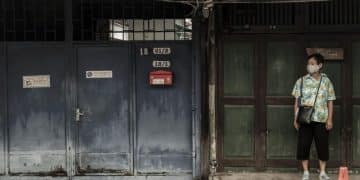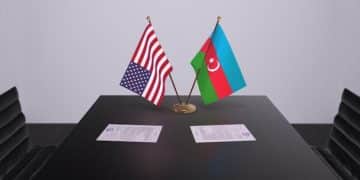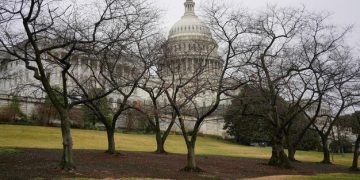US Policy on North Korea: Sanctions and Diplomacy Effectiveness

US policy on North Korea primarily involves sanctions and diplomatic efforts aimed at denuclearization and regional stability; however, the effectiveness of these measures remains a subject of ongoing debate due to North Korea’s persistent pursuit of nuclear weapons and complex geopolitical factors.
The US Policy on North Korea: Evaluating the Effectiveness of Current Sanctions and Diplomatic Efforts is a complex subject. The policy involves a mix of sanctions and diplomatic overtures intended to curb North Korea’s nuclear ambitions and promote regional stability. But are these efforts really working?
Understanding the Historical Context of US Policy Toward North Korea
To fully understand the current US policy toward North Korea, it’s crucial to delve into its historical roots. The relationship between the United States and North Korea has been fraught with tension and conflict since the Korean War in the 1950s. Understanding this history helps explain the present-day dynamics.
The Korean War (1950-1953) was a pivotal moment, setting the stage for decades of antagonism. The armistice agreement that ended the war did not lead to a peace treaty, leaving the Korean Peninsula divided and technically still at war. This unresolved conflict has been a major factor shaping US policy.

Key Historical Events Shaping US-North Korea Relations
Several key events have significantly influenced the trajectory of US-North Korea relations. These events include:
- The Korean War: The war solidified the division of the Korean Peninsula and established a strong US military presence in South Korea.
- The Cold War: The broader geopolitical context of the Cold War amplified tensions, with North Korea aligning with the Soviet Union and China.
- North Korea’s Nuclear Ambitions: The pursuit of nuclear weapons by North Korea has consistently heightened concerns and driven US policy responses.
- Periodic Crises and Negotiations: Numerous crises, such as the 1994 nuclear crisis and subsequent Six-Party Talks, have punctuated the relationship.
These historical events have created a complex web of distrust and animosity, making it difficult to find common ground and lasting solutions. The legacy of these events continues to shape the contours of US policy toward North Korea today.
In conclusion, the historical context of US policy toward North Korea is essential for grasping the nuances of current strategies. The Korean War, the Cold War, and North Korea’s nuclear ambitions have all played critical roles in shaping the relationship. Understanding this history provides a foundation for evaluating the effectiveness of current sanctions and diplomatic efforts.
Decoding Current US Sanctions Against North Korea
Sanctions form a cornerstone of current US policy toward North Korea. These measures aim to pressure North Korea to abandon its nuclear weapons program by limiting its access to resources necessary for its development. Examining the scope and effectiveness of these sanctions is critical.
The US sanctions regime against North Korea is multi-layered, involving unilateral US sanctions as well as those imposed by the United Nations Security Council. These sanctions target various sectors of the North Korean economy, including:
Key Sectors Targeted by US Sanctions
- Financial Institutions: Sanctions target banks and financial institutions that conduct business with North Korea.
- Trade: Restrictions are placed on trade involving goods, services, and technology that could contribute to North Korea’s weapons programs.
- Shipping: Measures are in place to prevent North Korea from using maritime routes for illicit activities.
- Luxury Goods: Bans on the export of luxury goods aim to impact the elite and undermine their support for the regime.
The intention of these sanctions is to squeeze North Korea economically, making it harder for the country to fund its nuclear and missile programs. However, the effectiveness of these sanctions is a subject of ongoing debate. Some argue that they have had a significant impact, while others believe that North Korea has been able to circumvent them through various means, including smuggling and cybercrime.

In conclusion, current US sanctions against North Korea are a complex and multifaceted tool designed to pressure the country to denuclearize. While these sanctions have undoubtedly created economic challenges for North Korea, their overall effectiveness remains a contentious issue. The ability of North Korea to adapt and circumvent these measures highlights the need for a more comprehensive and adaptive strategy.
Evaluating the Role of Diplomacy in US-North Korea Relations
While sanctions dominate much of the discussion surrounding US policy toward North Korea, diplomatic efforts also play a crucial role. These efforts aim to engage North Korea in dialogue and negotiations, seeking a peaceful resolution to the nuclear issue. Understanding the history and potential of diplomacy is essential.
Diplomatic engagement with North Korea has been sporadic and often fraught with challenges. Despite periods of heightened tension, there have also been moments of breakthrough and progress. Key diplomatic initiatives include:
- The Agreed Framework (1994): This agreement temporarily froze North Korea’s plutonium production in exchange for energy assistance.
- The Six-Party Talks: These talks involved the US, North Korea, South Korea, China, Japan, and Russia, aiming to denuclearize the Korean Peninsula.
- Bilateral Summits: High-level meetings between US and North Korean leaders have occurred, most notably during the Trump administration.
Each of these diplomatic initiatives has had its own successes and failures. The Agreed Framework eventually collapsed due to North Korea’s continued pursuit of nuclear weapons. The Six-Party Talks stalled after years of negotiations. Bilateral summits have yielded some progress but have not resulted in a comprehensive agreement.
Challenges and Opportunities in Diplomatic Engagement
Several factors complicate diplomatic engagement with North Korea. These include:
- Distrust: A deep-seated distrust exists between the US and North Korea, stemming from historical conflicts and broken agreements.
- Conflicting Objectives: The two countries have divergent goals, with the US seeking denuclearization and North Korea seeking security guarantees and recognition.
- Internal Politics: Domestic political considerations in both countries can impact the willingness to engage in diplomacy.
Despite these challenges, diplomacy remains an essential tool in managing the relationship with North Korea. A sustained and nuanced diplomatic strategy, coupled with a clear understanding of North Korea’s motivations, could potentially lead to a breakthrough in the nuclear issue.
In conclusion, diplomacy is a critical component of US policy toward North Korea. While it has faced numerous challenges and setbacks, it remains the most viable path toward a peaceful resolution. A renewed commitment to diplomatic engagement, based on realistic expectations and a willingness to address North Korea’s concerns, could pave the way for a more stable and secure future.
Analyzing Humanitarian Aid and Its Impact on North Korea
Another aspect of US policy toward North Korea, often overshadowed by sanctions and diplomacy, is the provision of humanitarian aid. This aid aims to alleviate suffering among the North Korean population, particularly vulnerable groups such as children, the elderly, and those affected by natural disasters. Understanding the role and impact of humanitarian aid is crucial for a comprehensive assessment.
The United States has been a significant provider of humanitarian assistance to North Korea, although the scale and scope of this aid have varied over time. Humanitarian aid typically includes:
- Food Assistance: Providing food aid to address chronic food shortages and malnutrition.
- Medical Supplies: Supplying essential medicines and medical equipment to improve healthcare access.
- Disaster Relief: Offering assistance in response to natural disasters such as floods and droughts.
The Dilemma of Humanitarian Aid
The provision of humanitarian aid to North Korea is often fraught with dilemmas. One key concern is ensuring that aid reaches the intended recipients and is not diverted for other purposes. Monitoring and verification mechanisms are essential to prevent aid from being used to support the regime or its military.
Another challenge is balancing humanitarian concerns with political objectives. Some argue that providing aid could inadvertently prop up the regime, while others contend that withholding aid would only exacerbate the suffering of the North Korean people. Finding the right balance requires careful consideration and a nuanced approach.
Despite these challenges, humanitarian aid remains an important tool in engaging with North Korea. It can help build trust and create opportunities for dialogue. It also sends a message of compassion and concern for the well-being of the North Korean people.
In conclusion, humanitarian aid plays a significant role in US policy toward North Korea, albeit one that is often overshadowed by political and security considerations. While challenges exist in ensuring that aid reaches those in need, it remains a vital tool for alleviating suffering and promoting engagement. A continued commitment to humanitarian principles, coupled with robust monitoring mechanisms, can help ensure that aid has a positive impact on the lives of the North Korean people.
Assessing the Influence of Regional Powers on US Policy
US policy toward North Korea is not formulated in a vacuum. It is significantly influenced by the actions and interests of regional powers, particularly China, South Korea, Japan, and Russia. Understanding the dynamics of these relationships is crucial for evaluating the effectiveness of US strategies.
China is arguably the most influential regional player. As North Korea’s closest ally and largest trading partner, China has significant leverage over the country. China’s priorities include maintaining stability on the Korean Peninsula, preventing a collapse of the North Korean regime, and avoiding a military conflict. China often plays a mediating role, urging both the US and North Korea to engage in dialogue.
The Role of South Korea and Japan
South Korea and Japan are also key players in the region. South Korea has a direct stake in the stability of the Korean Peninsula, given its proximity to North Korea and the potential for a military confrontation. South Korea often pursues a dual-track approach, combining deterrence with engagement.
Japan, on the other hand, has concerns about North Korea’s missile program and its potential to target Japanese territory. Japan typically supports a strong stance against North Korea, including sanctions and military deterrence.
- China: Seeks stability and mediates between the US and North Korea.
- South Korea: Pursues a dual-track approach of deterrence and engagement.
- Japan: Supports a strong stance against North Korea.
- Russia: Aims to play a greater role in regional security.
Russia also has interests in the region and seeks to play a greater role in shaping the security landscape. Russia often aligns with China on North Korea issues, advocating for a peaceful resolution and opposing unilateral sanctions.
In conclusion, regional powers exert a significant influence on US policy toward North Korea. China, South Korea, Japan, and Russia all have distinct interests and priorities that shape their interactions with North Korea and their relationships with the United States. A successful US policy must take into account these regional dynamics and seek to build consensus and cooperation among the key players.
Examining Future Directions for US Policy on North Korea
Looking ahead, there are several potential directions for US policy on North Korea. The current approach, which combines sanctions and diplomacy, may need to be recalibrated to address the evolving challenges and opportunities. Examining these future directions is essential for developing a more effective strategy.
One potential direction is a more comprehensive diplomatic approach. This would involve sustained engagement with North Korea, based on realistic expectations and a willingness to address North Korea’s security concerns. It could also involve multilateral negotiations, bringing together all the key regional players.
Considering Alternative Approaches
Another potential direction is a more targeted sanctions regime. This would involve focusing sanctions on specific individuals and entities involved in North Korea’s weapons programs, while minimizing the impact on the civilian population. It could also involve enhanced enforcement measures to prevent sanctions evasion.
- Comprehensive Diplomacy: Sustained engagement with North Korea and multilateral negotiations.
- Targeted Sanctions: Focusing sanctions on specific individuals and entities involved in weapons programs.
- Increased Deterrence: Strengthening military alliances and enhancing defense capabilities.
A third potential direction is a greater emphasis on deterrence. This would involve strengthening military alliances with South Korea and Japan, enhancing defense capabilities, and signaling a clear commitment to defend against any North Korean aggression.
In conclusion, the future of US policy on North Korea will likely involve a combination of these approaches. A successful strategy must be adaptable, flexible, and based on a clear understanding of North Korea’s motivations and the regional dynamics. It must also be grounded in a commitment to both denuclearization and the well-being of the North Korean people.
| Key Point | Brief Description |
|---|---|
| 📜 Historical Context | Understanding the Korean War and Cold War’s impact on current relations. |
| 💰 Sanctions | Evaluating the effectiveness of economic sanctions on North Korea’s nuclear program. |
| 🤝 Diplomacy | Assessing the role of diplomatic efforts in resolving the North Korean nuclear issue. |
| 🌍 Regional Influence | Analyzing the influence of China, South Korea, and Japan on US policy. |
Frequently Asked Questions
▼
The primary goals include denuclearization, regional stability, and addressing human rights concerns. The US aims to prevent North Korea from developing and proliferating nuclear weapons.
▼
Sanctions have created economic challenges for North Korea but have not fully halted its nuclear program. The country continues to find ways to circumvent sanctions.
▼
Diplomacy aims to engage North Korea in dialogue and negotiations to peacefully resolve the nuclear issue. However, distrust and conflicting objectives pose significant challenges.
▼
Humanitarian aid aims to alleviate suffering among the North Korean population, particularly vulnerable groups. Challenges include ensuring aid reaches the intended recipients and balancing political objectives.
▼
China, South Korea, Japan, and Russia all exert significant influence. Their distinct interests and priorities shape interactions with North Korea and relationships with the US.
Conclusion
In conclusion, US policy on North Korea: evaluating the effectiveness of current sanctions and diplomatic efforts requires a multifaceted approach that considers historical context, economic pressures, diplomatic engagement, and regional dynamics. While sanctions and diplomacy remain key tools, their effectiveness hinges on adaptability, comprehensive strategies, and a clear understanding of both North Korea’s motivations and the broader geopolitical landscape.





